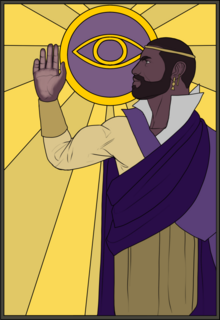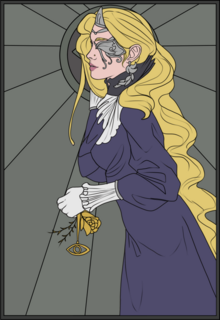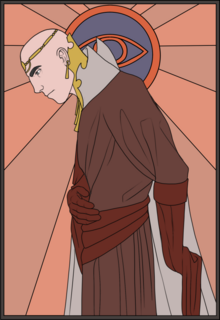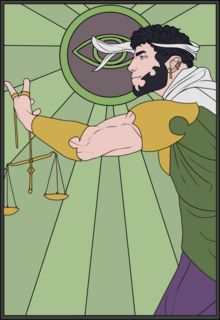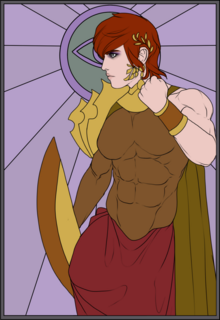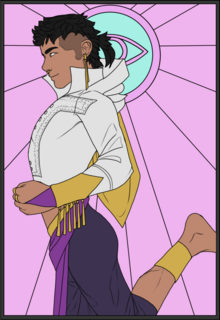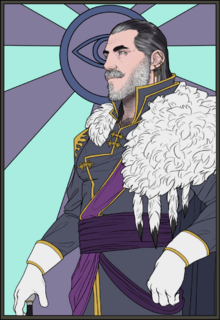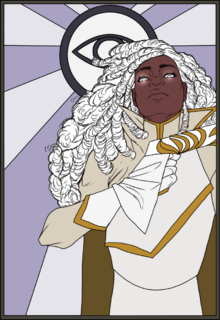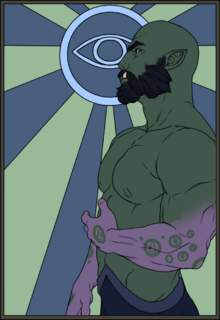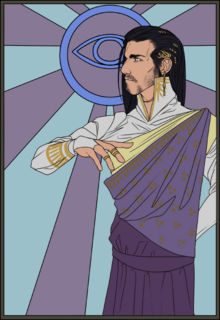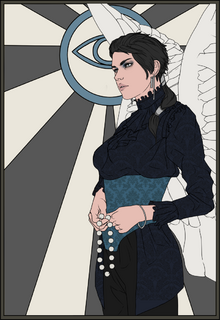More actions
mNo edit summary |
|||
| Line 15: | Line 15: | ||
|} | |} | ||
=== | ===Theomos, Prophet of All=== | ||
{| | {| | ||
|[[File:GodTheomar.png|220px|thumb|left]] | |[[File:GodTheomar.png|220px|thumb|left]] | ||
| | | | ||
*'''Identity:''' God Emperor | *'''Identity:''' God Emperor Theomos, nicknamed the Sun-Father, first Emperor of the Regalian Empire and Prophet of Unionism. | ||
*'''Themes:''' | *'''Themes:''' Theomos represents fatherhood, leadership, ambition, devotion and piety. He is remembered for his exceptional charisma and as a loving father who founded an imperial dynasty. | ||
*'''Depictions:''' | *'''Depictions:''' Theomos is often depicted holding up his hand, with the palm to the viewer. He is always depicted very dignified, and clothed in his royal purple and cream yellow robes, his favorite colors in life. | ||
*'''Worship:''' Worship to | *'''Worship:''' Worship to Theomos is performed by writing prayers of good health and good fortune for children/employees/followers on pieces of paper and burning them in golden bowls. | ||
*'''Manifestation:''' | *'''Manifestation:''' Theomos has manifested only during very significant events of religious importance, when the continued existence of Unionism hung by a thread, or when the power and influence of the other God Emperors or Empresses would simply not suffice for a task given by the Everwatcher. | ||
*'''Individual:''' | *'''Individual:''' Theomos has never appeared to sole individuals, but rather during pivotal moments of the Empire’s history to provide blessings of protection and reinvigorated power. | ||
*'''Worship House:''' | *'''Worship House:''' Theomos’s main Temple is the Arch Temple of the All-Beacon in Regalia, buried beneath the shrine known as the Dias of Faith. | ||
|} | |} | ||
=== | ===Nes, Lady of Forgiveness=== | ||
{| | {| | ||
|[[File:GoddessNess.png|220px|thumb|left]] | |[[File:GoddessNess.png|220px|thumb|left]] | ||
| | | | ||
*'''Identity:''' God Empress | *'''Identity:''' God Empress Nes, nicknamed the All-Mother, was the wife of Emperor Henri I, Nessaria van Sherburne | ||
*'''Themes:''' | *'''Themes:''' Nes represents Forgiveness, Acceptance, Repentance, Absolution, but also the Downtrodden, the Forgotten, the non-Ailor, and the Half-Ailor who feel abandoned. | ||
*'''Depictions:''' | *'''Depictions:''' Nes is always depicted in her mourning dress with her signature butterfly eye-covers worn after she was blinded for her unfaithfulness to her husband, carrying a golden Unionist Eye chain, along with a golden rose and two sets of rose-thorn stalks. Sometimes her statue has three infants around her pedestal to signify motherhood, and sometimes it has three chained criminals to signify the forgiveness she gave. | ||
*'''Worship:''' Worship to | *'''Worship:''' Worship to Nes is done by lighting candles in silent vigil, or by seeking priests to find forgiveness for wronging others. | ||
*'''Manifestation:''' | *'''Manifestation:''' Nes frequently manifests to those who believe in Unionism, but need the strongest forgiveness or cannot go on without help to learn to live with their grief, guilt, or torment | ||
*'''Individual:''' | *'''Individual:''' Nes appears to individuals relatively often, even seen walking the streets of Regalia seemingly going nowhere. | ||
*'''Worship House:''' | *'''Worship House:''' Nes's main Temple is the Arch Temple of Salvation in Regalia. She is buried alongside her children: Emperors Bartholomeaux, Carvallais, Maxelle, and Leomar (the former three having been victims of assassination), and Arch-Chancellor Maenarra. | ||
|} | |} | ||
=== | ===Tzarvin, Oracle of Knowledge=== | ||
{| | {| | ||
|[[File:GodJuvin.png|220px|thumb|left]] | |[[File:GodJuvin.png|220px|thumb|left]] | ||
| | | | ||
*'''Identity:''' God Emperor | *'''Identity:''' God Emperor Tzarvin, nicknamed the All-Knower, was the 11th Emperor of the Regalian Empire, Henri III Ivrae de Sange. | ||
*'''Themes:''' | *'''Themes:''' Tzarvin represents piety and virtue, the perfection of learning, and thinkers. | ||
*'''Depictions:''' | *'''Depictions:''' Tzarvin is often depicted in simple garb with only minimal decorations and dull colors, bowing, kneeling or in some form of submissive stance. He is depicted tall and frail, with a bald head and a long robe that may sometimes also contain several scrolls and items that intellectuals use to ply their crafts. | ||
*'''Worship:''' Worship to | *'''Worship:''' Worship to Tzarvin is done by lighting candles to his will in front of a shrine inside a bookshelf, while incense is lit to absorb the knowledge of the books, in the hopes that Juvin will give the worshipper the means to learn faster. | ||
*'''Manifestation:''' | *'''Manifestation:''' Tzarvin rarely manifests, but all appearances have been reported in libraries or other places of learning. | ||
*'''Individual:''' | *'''Individual:''' Tzarvin rarely appears to individuals, handing them exactly the one book they were looking for to embark on their journey, while that book was not even in the library to begin with. | ||
*'''Worship House:''' | *'''Worship House:''' Tzarvin's main Temple is the Arch Temple of Greater Understanding, where he is buried within the Inner Faith Chamber. | ||
|} | |} | ||
=== | ===Almaros, Jester of Justice=== | ||
{| | {| | ||
|[[File:GodAlmar.png|220px|thumb|left]] | |[[File:GodAlmar.png|220px|thumb|left]] | ||
| | | | ||
*'''Identity:''' God Emperor | *'''Identity:''' God Emperor Almaros, nicknamed the Blind Jester, was the 13th Emperor of the Regalian Empire, Allamaria Ivrae Heiligenblut (surname different as he was culturally Wirtem). | ||
*'''Themes:''' | *'''Themes:''' Almaros represents Justice, Law, Honesty, but also of Leisure, Entertainment, Vanity, and Ego. | ||
*'''Depictions:''' | *'''Depictions:''' Almaros is often depicted as a suave and handsome young man, always with either a blindfold or some kind of unraveling cloth disappearing from his eyes. He is also always depicted with a scale that weighs the value of crime and punishment for those who are subject to Almar’s laws. | ||
*'''Worship:''' Worship to Almar is done by writing one's plan or thought on a piece of paper, and weighing it against a golden feather to determine if it is lawful and righteous (lighter) or unlawful and sinful (heavier). | *'''Worship:''' Worship to Almar is done by writing one's plan or thought on a piece of paper, and weighing it against a golden feather to determine if it is lawful and righteous (lighter) or unlawful and sinful (heavier). | ||
*'''Manifestation:''' | *'''Manifestation:''' Almaros is not known to manifest, but the Silent Council still acknowledges him. | ||
*'''Individual:''' | *'''Individual:''' Almaros has never appeared to individuals. | ||
*'''Worship House:''' | *'''Worship House:''' Almaros's main Temple is the Arch Temple of Eternal Justice, where the Inner Faith chamber holds his sarcophagus with his favorite scales resting on top that are said to weight the heaviness of a soul as they enter the chamber. | ||
|} | |} | ||
=== | ===Allestos, Lord of Domination=== | ||
{| | {| | ||
|[[File:GodAllest.png|220px|thumb|left]] | |[[File:GodAllest.png|220px|thumb|left]] | ||
| | | | ||
*'''Identity:''' God Emperor | *'''Identity:''' God Emperor Allestos, nicknamed the Bear-Claw, was the 15th Emperor of the Regalian Empire, Allestrain I Ivrae de Sange. | ||
*'''Themes:''' | *'''Themes:''' Allestos represents Conquest, Rule, Brotherhood, and Fame. | ||
*'''Depictions:''' | *'''Depictions:''' Allestos is depicted either in his massive bulky armor, or in some state of removal of this armor, in a victorious or intimidating stance. He is depicted tall and glorious with two large claymores, or scabbards holding his favorite swords: Blutkraft and [[Sangria]], weapons that passed into Artifact Legend after his death. | ||
*'''Worship:''' Worship to | *'''Worship:''' Worship to Allestos is done by invoking his name before battle, and by ritually placing a weapon over a cloth soaked in an alcoholic beverage. | ||
*'''Manifestation:''' | *'''Manifestation:''' Allestos has manifested after the end of major battles, not to fight, but to mourn the losses on the battlefield with the survivors. | ||
*'''Individual:''' | *'''Individual:''' Allestos has never appear to the individual, though occasionally those who have lost lovers to the battlefield swear he has appeared in dreams for comfort. | ||
*'''Worship House:''' | *'''Worship House:''' Allestos's main Temple is the Arch Temple of Perpetual Glory, where the Inner Faith Chamber contains his battle armor (as he was killed in battle and his body was never recovered). | ||
|} | |} | ||
=== | ===Ellis, Mistress of Victory=== | ||
{| | {| | ||
|[[File:GoddessElia.png|220px|thumb|left]] | |[[File:GoddessElia.png|220px|thumb|left]] | ||
| | | | ||
*'''Identity:''' God Empress | *'''Identity:''' God Empress Ellis, nicknamed the Brass Fist, was the Empress-Consort of Emperor Allestrain I, Eolaria Cadar. | ||
*'''Themes:''' | *'''Themes:''' Ellis represents fighting, combat, warfare, victory, love, and loss. | ||
*'''Depictions:''' | *'''Depictions:''' Ellis is often depicted with her fist up, sometimes with or without her spiked war-glove Porcelain-Face, but always with her shield Draackenbuster by her side. She always wears a muscle-fitting bronze armor with a long crimson dress (which she did not wear into battle) complementing her crimson hair. | ||
*'''Worship:''' Worship to | *'''Worship:''' Worship to Ellis is to hold a diary, and to write down secrets and worries and lock it away into the stronghold-lockbox, a religious item that Unionists consider a great sin to steal from. | ||
*'''Manifestation:''' | *'''Manifestation:''' Ellis has never manifested, though many claim that she has appeared on select battlefields while the Empire was expanding, leading a divine charge. | ||
*'''Individual:''' | *'''Individual:''' EliaEllis has never appeared to individuals, though she left behind several holy Artifacts, most in the Imperial Palace. | ||
*'''Worship House:''' | *'''Worship House:''' Ellis's main Temple is the Arch Temple of Unyielding Perseverance in Regalia, though the sarcophagus next to hers is empty, reserved for Emperor Allestrain I whose body remains missing to this day. | ||
|} | |} | ||
=== | ===Esper, Liberator of Chains=== | ||
{| | {| | ||
|[[File:Hfhdf.png|220px|thumb|left]] | |[[File:Hfhdf.png|220px|thumb|left]] | ||
| | | | ||
*'''Identity:''' God Emperor | *'''Identity:''' God Emperor Esper, nicknamed the Freedom-Maker, was the 26th Emperor of the Regalian Empire, Vilgemar Ivrae de Sange. | ||
*'''Themes:''' | *'''Themes:''' Esper represents happiness, liberty, liberation, freedom, and emancipation. | ||
*'''Depictions:''' | *'''Depictions:''' Esper is always depicted as a very youthful looking young man, wearing the traditional garb of the palace entertainers, and is always standing in some sort of playful position or pose that elicits some sense of playfulness or youthfulness. | ||
*'''Worship:''' Worship to | *'''Worship:''' Worship to Esper is done by releasing wishes and prayers into budding flowers, and then placing said flower into a body of water to be released into the world. | ||
*'''Manifestation:''' | *'''Manifestation:''' Esper has rarely manifested, though every time has been to smash the chains of a group of slaves, or freeing them from a burning barn or barrack. | ||
*'''Individual:''' | *'''Individual:''' Esper has rarely appeared to enslaved individuals, offering them the keys needed to escape from their chains. | ||
*'''Worship House:''' | *'''Worship House:''' Esper's main Temple is the Arch Temple of Joyous Everwatch, where the Inner Faith Chamber contains his sarcophagus surrounded by a sea of broken chains, each belong to a slave he helped free. | ||
|} | |} | ||
=== | ===Alexandros, Mentor of Compromise=== | ||
{| | {| | ||
|[[File:Alexandro.png|220px|thumb|left]] | |[[File:Alexandro.png|220px|thumb|left]] | ||
| | | | ||
*'''Identity:''' Divine Vessel | *'''Identity:''' Divine Vessel Alexandros is the current Emperor of the Regalian Empire, Alexander Kade Alltmeister. | ||
*'''Themes:''' Emperor | *'''Themes:''' Emperor Alexandros is the Divine Vessel of change, reform, compassion, compromise and mentorship. | ||
*'''Depictions:''' | *'''Depictions:''' Alexandros is depicted in his full imperial regalia, with every government institute and office having a large life-size or greater painting or statue of Him. | ||
*'''Worship:''' As the Vessel, | *'''Worship:''' As the Vessel, Alexandros is not worshipped directly, but rather through service to the Regalian Empire or by praying to the Everwatcher for his health and wellbeing. | ||
*'''Manifestation:''' | *'''Manifestation:''' Alexandros is still alive, and is frequently seen when holding Audiences at the Imperial Palace. | ||
*'''Individual:''' As the Emperor, | *'''Individual:''' As the Emperor, Alexandros rarely interacts with individuals outside of public settings, though some nobles and faithful have been able to secure a personal audience with Him. | ||
*'''Worship House:''' | *'''Worship House:''' Alexandros has no official Temples to Him personally, but the Temple of the Vessel-Vigil in Etosil is the dedicated Evintarian Worship House to any living Emperor. | ||
|} | |} | ||
Revision as of 14:11, 7 August 2022
Gods and Goddesses
Unionism has a concept referred to as Trans-Divinity. Trans-Divinity means that whatever their faith understands to be divine, is fluid and constantly changes based on interpretations. By standard, the Everwatcher is always the indisputably most important entity in Unionism. The Living Emperor is also a living Divine Being who should be worshiped as a god, though it is not illegal to acknowledge his sin of creation flaws from time to time. Below the Emperor and the Everwatcher are the God-Emperors and God-Empresses. When an Emperor or Empress dies, they are no longer divine, as the Vessel passes on to the next heir, but some Emperors or Empresses are raised up in the afterlife by the Everwatcher and sent back to Aloria to guide the people, during which process they are made Divine Beings. Finally, on the lower end of the spectrum are the Heroes of Unionism, which are also considered Divine Beings. Heroes are raised to divinity by the Concilly Council even while they are still alive, and continue to be worshiped after death. This all means that Unionism, as time goes by, gains more and more Gods and Goddesses, while other religions are fairly stagnant. Furthermore, it also means that it’s theoretically possible for other religions to merge into Unionism if their Gods and Goddesses can be proven to be real, and prove their divinity or past divinity. Unionists can combine a variety of Divine Entity worship. By default, all Unionists worship the Everwatcher, however, whoever else is worshiped additionally is up to the individual. Some worshipers choose only a single patron deity, while others choose a collection, or leave just a few out. There are no hard rules to Divine Being worship, in general they exist more as examples to live by, instead of a strict pantheon that demands worship.
The Everwatcher
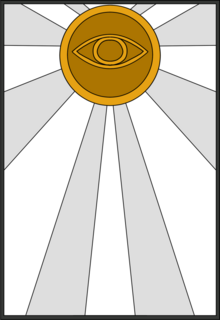 |
|
Theomos, Prophet of All
Nes, Lady of Forgiveness
Tzarvin, Oracle of Knowledge
Almaros, Jester of Justice
Allestos, Lord of Domination
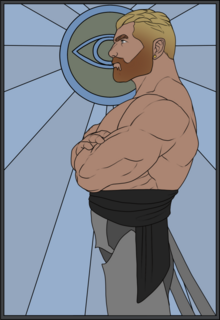 |
|
